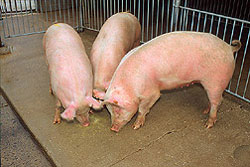



Researchers Study New Class of Deworming Agent
US - After two moderate doses of a bacteria-derived protein were fed to worm-infected swine in an experiment, all intestinal roundworm larvae in the swine were damaged or destroyed and the infection was nearly completely eliminated, according to US Department of Agriculture (USDA) and University of California-San Diego scientists.
The research team included microbiologist Joseph Urban and his colleagues at the USDA Agricultural Research Service (ARS) Beltsville Human Nutrition Research Center in Beltsville, Maryland, and Raffi Aroian and Yan Hu at the University of California-San Diego. ARS is USDA's chief intramural scientific research agency.
The parasitic roundworm that commonly infects pigs is Ascaris suum, which is genetically similar to A. lumbricoides, a roundworm species that infects about 1 billion people worldwide. A. suum infection in pigs is considered a good model for A. lumbricoides infection in humans because of its similar migration through the body and to the intestines.
During the experiments, the team used a crystal protein called "Cry5B," provided by Dr Aroian's group, which is derived from the soil bacterium Bacillus thuringiensis. Cry5B protein is considered nontoxic to vertebrates and mammals.
The dosage the team provided in the study is comparable to the dose range used in existing commercial antiparasitic drugs. The results show the potential of Cry5B to treat Ascaris infections in pigs and other livestock and to work effectively in the human gastrointestinal tract, according to authors. The team described the research in a 2013 article published in PLOS: Neglected Tropical Diseases.
There is a need for more practical delivery systems for antiparasitic drug treatments, according to the scientists, and further cooperative research is planned.
You can read more about this research in the May/June 2014 issue of Agricultural Research magazine by clicking here.








